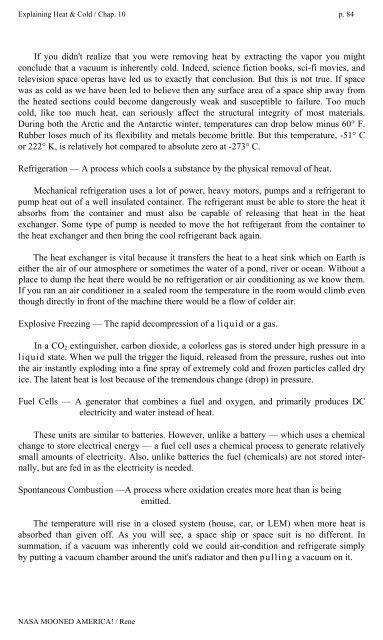Rene-NASA-Mooned-America
Rene-NASA-Mooned-America
Rene-NASA-Mooned-America
You also want an ePaper? Increase the reach of your titles
YUMPU automatically turns print PDFs into web optimized ePapers that Google loves.
Explaining Heat & Cold / Chap. 10 p. 84<br />
If you didn't realize that you were removing heat by extracting the vapor you might<br />
conclude that a vacuum is inherently cold. Indeed, science fiction books, sci-fi movies, and<br />
television space operas have led us to exactly that conclusion. But this is not true. If space<br />
was as cold as we have been led to believe then any surface area of a space ship away from<br />
the heated sections could become dangerously weak and susceptible to failure. Too much<br />
cold, like too much heat, can seriously affect the structural integrity of most materials.<br />
During both the Arctic and the Antarctic winter, temperatures can drop below minus 60° F.<br />
Rubber loses much of its flexibility and metals become brittle. But this temperature, -51° C<br />
or 222° K, is relatively hot compared to absolute zero at -273° C.<br />
Refrigeration — A process which cools a substance by the physical removal of heat.<br />
Mechanical refrigeration uses a lot of power, heavy motors, pumps and a refrigerant to<br />
pump heat out of a well insulated container. The refrigerant must be able to store the heat it<br />
absorbs from the container and must also be capable of releasing that heat in the heat<br />
exchanger. Some type of pump is needed to move the hot refrigerant from the container to<br />
the heat exchanger and then bring the cool refrigerant back again.<br />
The heat exchanger is vital because it transfers the heat to a heat sink which on Earth is<br />
either the air of our atmosphere or sometimes the water of a pond, river or ocean. Without a<br />
place to dump the heat there would be no refrigeration or air conditioning as we know them.<br />
If you ran an air conditioner in a sealed room the temperature in the room would climb even<br />
though directly in front of the machine there would be a flow of colder air.<br />
Explosive Freezing — The rapid decompression of a liquid or a gas.<br />
In a CO 2 extinguisher, carbon dioxide, a colorless gas is stored under high pressure in a<br />
liquid state. When we pull the trigger the liquid, released from the pressure, rushes out into<br />
the air instantly exploding into a fine spray of extremely cold and frozen particles called dry<br />
ice. The latent heat is lost because of the tremendous change (drop) in pressure.<br />
Fuel Cells — A generator that combines a fuel and oxygen, and primarily produces DC<br />
electricity and water instead of heat.<br />
These units are similar to batteries. However, unlike a battery — which uses a chemical<br />
change to store electrical energy — a fuel cell uses a chemical process to generate relatively<br />
small amounts of electricity. Also, unlike batteries the fuel (chemicals) are not stored internally,<br />
but are fed in as the electricity is needed.<br />
Spontaneous Combustion —A process where oxidation creates more heat than is being<br />
emitted.<br />
The temperature will rise in a closed system (house, car, or LEM) when more heat is<br />
absorbed than given off. As you will see, a space ship or space suit is no different. In<br />
summation, if a vacuum was inherently cold we could air-condition and refrigerate simply<br />
by putting a vacuum chamber around the unit's radiator and then pulling a vacuum on it.<br />
<strong>NASA</strong> MOONED AMERICA! / <strong>Rene</strong>


